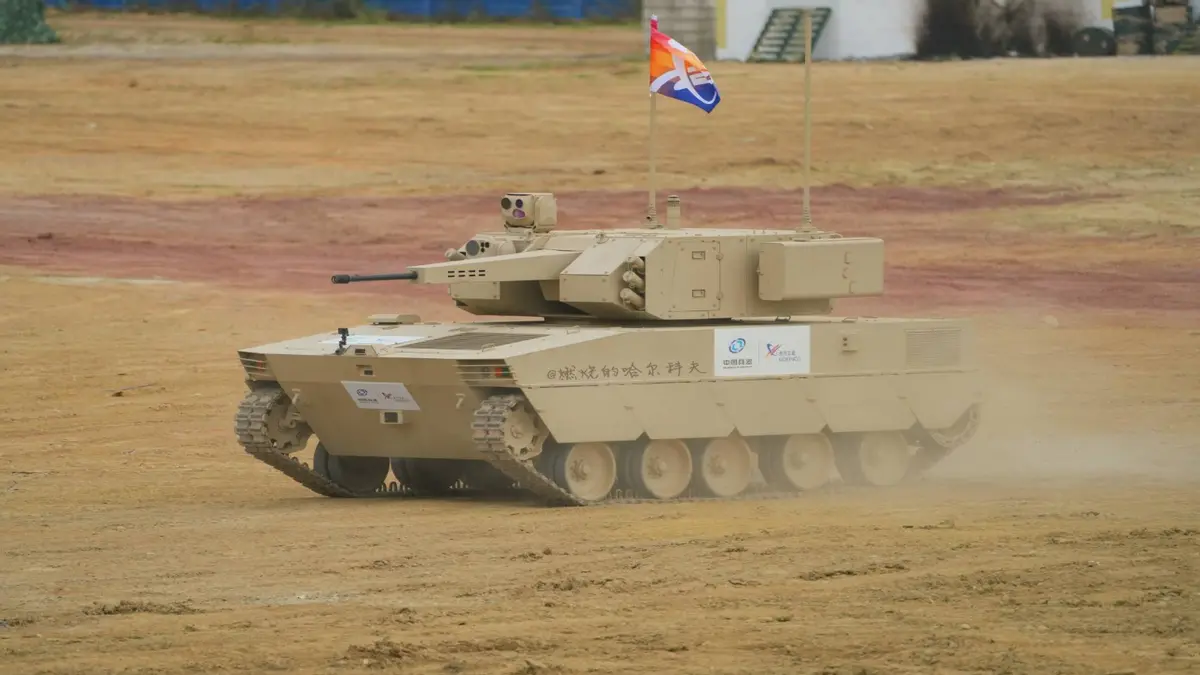China North Industries Group Corporation (NORINCO) has completed a public demonstration of the VU‑T10 unmanned ground vehicle (UGV), a tracked, remotely operated combat platform designed for integration into networked military operations. The test, which included live-fire exercises, took place in mountainous terrain and was accompanied by integrated demonstrations with other unmanned systems.
The VU‑T10 is an 11-ton electric-powered vehicle armed with a 30 mm autocannon, coaxial machine guns and smoke grenade launchers. Some configurations also support the Red Arrow 12 anti-tank guided missile system. According to NORINCO, the vehicle has a top speed of 60 km/h and a maximum operational range of approximately 100 kilometers.
These capabilities position the VU‑T10 for use in direct fire support roles, particularly in environments that present high risk to human operators, such as urban terrain or hostile frontlines. Its relatively compact size and modular design suggest flexibility for both offensive and defensive deployments.
- VU-T10 at IDEX 2023. (Mztourist/Wikimedia)
Integration with emerging military doctrine
The VU‑T10 appears to be one component of a broader effort by the People’s Liberation Army (PLA) to incorporate unmanned-unmanned teaming (MUM-T) into its ground forces. During recent tests, NORINCO demonstrated the UGV’s interoperability with aerial drones, robotic quadrupeds, and long-range missile units.
Chinese defense planners have previously emphasized the importance of distributed lethality and multi-domain operations. The VU‑T10 fits into this framework, providing an unmanned ground platform that can operate as part of a networked combat system—potentially improving real-time response, reducing troop exposure, and increasing battlefield reach.
Ethical and Operational Considerations
The emergence of armed unmanned ground vehicles like the VU‑T10 has sparked a new debate about the ethical, legal, and operational implications of increasing automation in warfare.
While current models are operated by human controllers, NORINCO’s emphasis on autonomous capabilities points to potential future upgrades, including onboard decision-making, target recognition, and semi-autonomous engagement protocols. This raises challenges in areas such as target discrimination, compliance with international humanitarian law, and command accountability.
Questions remain about how autonomous systems will operate on the battlefield – particularly in complex environments where civilians may be present. Misidentifications or errors in threat assessment could lead to unintended engagements. Furthermore, the increasing role of software and AI in weapons systems introduces ambiguity in the chain of responsibility, which complicates legal and ethical oversight.
International discussions on lethal autonomous weapons systems (LAWS) are ongoing, but no binding agreements have yet emerged. The introduction of systems such as the VU‑T10 could accelerate calls for a regulatory framework or multilateral agreements to guide the development and use of such technologies.
- VU-T10 rear at IDEX 2023. (Mztourist/Wikimedia)
Broad strategic implications
China is one of several countries investing in armed UGVs. The United States, Russia, Israel, and South Korea have also introduced similar platforms, although the levels of autonomy and operational integration vary.
NORINCO’s continued development of the VU‑T10 demonstrates its intention to remain competitive in this evolving space. The system has not yet been confirmed for export, but Chinese defense companies have previously displayed similar platforms at international arms exhibitions, indicating potential interest from foreign militaries.
As UGV technology matures and enters widespread service, military organizations and policymakers will need to weigh operational benefits against broader concerns regarding safety, surveillance, and the role of humans in combat decision-making.
Read More: U.S. Marines Deploy Ospreys in Undersea Hunt: First Home for Sonobuoy Launch Platforms
FAQs
The VU-T10 is an 11-ton electric-powered unmanned ground vehicle developed by China’s NORINCO. It is armed with a 30mm cannon, coaxial machine gun and optional Red Arrow 12 anti-tank missiles. Designed for remote operation, it can reach speeds of up to 60 km/h and has a range of around 100 km. Its primary role is to provide fire support in high-risk areas such as urban combat zones, reducing the need for human soldiers in dangerous situations.
The VU-T10 is part of China’s broader strategy to integrate unmanned systems into military operations, known as Unmanned Teaming (MUM-T). This approach combines human-controlled and autonomous systems to increase battlefield effectiveness. During recent tests, the VU-T10 demonstrated interoperability with aerial drones, robotic quadrupeds, and long-range missile units, demonstrating its role in a networked combat system.
The development of autonomous weapons raises significant ethical and legal questions. While current models are operated by humans, future upgrades could include onboard decision-making capabilities. This could lead to challenges in areas such as target discrimination, compliance with international humanitarian law, and accountability for actions taken by autonomous systems. Discussions on lethal autonomous weapons systems (LAWS) are ongoing, but no binding agreements have yet emerged.
China is one of several countries investing in armed unmanned ground vehicles. The United States, Russia, Israel, and South Korea have also introduced similar platforms, although the levels of autonomy and operational integration vary. NORINCO’s continued development of the VU-T10 demonstrates its intention to remain competitive in this evolving space. While this system has not yet been confirmed for export, Chinese defense companies have previously displayed similar platforms at international arms exhibitions, indicating potential interest from foreign militaries.








Leave a Reply